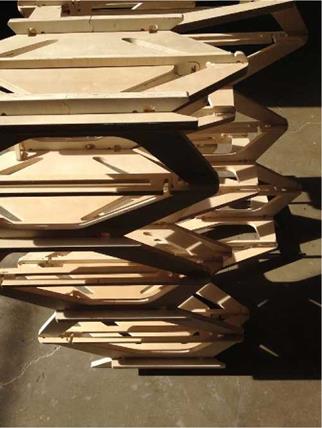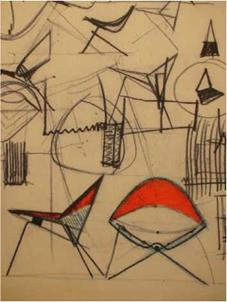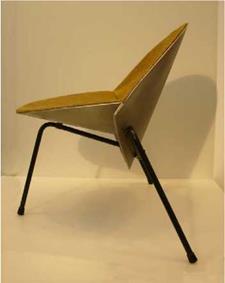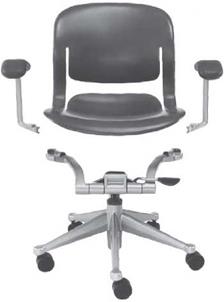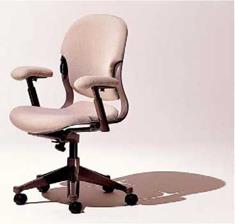 |
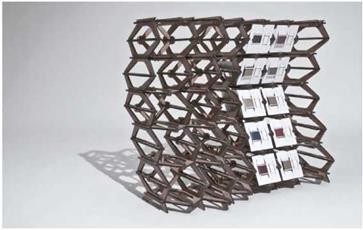 |
Digital software programs and digital machines have begun to affect our thinking about design. Greg Lynn is an architect and professor at UCLA who uses advanced computer technologies to design complex forms. Making full use of the digital characteristics and properties of the software Maya, Lynn conceived of a chair that resulted from the digital interpolation of several of Michael Thonet’s earlier bentwood chair designs. The idea is more significant than a study in digital representation. It marks a precedent for furniture design in which the capabilities of digital technology have extended beyond the human ability to generate (or comprehend) such innovative complex forms.
Digital technology is becoming more than just a tool in the design process. In some situations, it has become the vehicle and the means of generating form. In the School of Architecture and Interior Design at the University of Cincinnati, graduate student Jeff Welch used digital media and digital fabrication technology to design and fabricate a series of working prototypes leading toward a system that could contain, display, and organize material samples for the school’s material library (Figure 5.46). The design process, becoming ever more a standard, required computer numeric controlled (CNC) mill production. To express
|
|
||
the potential of a single material, Baltic birch plywood, it was required by the designer that the entire system be made with no mechanical fasteners or glue.
As a parametric process, the design was conceived from the bottom up. The parts and their relationships were initially developed based on tension and compression forces. The components and their joinery were continually adjusted to embody increasing parameters. Several digital and physical prototypes were developed, and each was evaluated to judge its adherence to the original parameters (Figures 5.47 and 5.48). It was essential to employ full-scale rapid prototyping to distill fit problems and tolerances as complexity increased. Making small adjustments to the parts would cause the system, as a whole, to activate. For instance, by offsetting the top of each part in relation to the bottom, the system would "bend."
The opportunity to reconsider traditional processes of design and fabrication is open to all designers now. And these opportunities may help designers in their inquiry to determine what makes good furniture good. Or, more to the point, digital technology can shape the very frame of reference used to determine how designers think about technical, functional, and aesthetic matters.
New Formalism: Theories of Digital Form 159
ENDNOTES
1. The American Heritage Dictionary of the English Language, 4th edition (copyright © 2000 by Houghton Mifflin Company, published by Houghton Mifflin Company).
2. Ibid.
3. www. brainyquote. com/quotes/l/ludwigmies.
4. www. wikipedia. org and Encyclopedia Britannica, 11th edition (1972).
5. The American Heritage Dictionary of the English Language, 4th edition.
6. Webster Illustrated Contemporary Dictionary, Encyclopedic Edition (Chicago: J. G. Ferguson, 1987).
7. W. Jastrzebowski, "An Outline of Ergonomics, or the Science of Work Based upon the Truths Drawn from the Science of Nature," originally published in Nature and Industry (1857), reprinted by the Central Institute for Labor Protection (1997), Warsaw, Poland.
8. Each year the Bureau of Labor Statistics (BLS) gathers data on the number, rate, and characteristics of occupational injuries and illnesses occurring in the private sector by the U. S. Department of Labor, published by the Occupational Safety and Health Administration (OSHA).
9. Ibid.
10. Clara A. Ridder, "Basic Design Measurements for Sitting," Agricultural Experiment Station. University of Arkansas, Fayetteville, 1959. Jack Hockenberry, "Seating Design," NATO Symposium, 1980. Hockenberry’s research was based on the work of Clara Ridder, introduced to the author by UC Industrial Design Professor Bradley Hammond. Using a seating machine to study and measure upright seating profiles in different individuals, Clara Ridder’s work resulted in an upright seating profile known as the Ridder Curve.
11. The American Heritage Stedman’s Medical Dictionary, 2nd edition (copyright © 2004 by Houghton Mifflin Company, published by Houghton Mifflin Company. All rights reserved).
12. J. J. Swearingen, C. D. Wheelwright, and J. D. Garner. "An Analysis of Sitting Areas and Pressure of Man" (Report 62-1) (Oklahoma City, OK: Civil Aero Medical Research Institute, 1962).
13. Paul Cornell, The Biometrics of Sitting, 2nd edition. This paper is an excerpt from a book by Marvin J. Dainoff, People and Productivity: A Manager’s Guide to Ergonomics (Toronto: Holt, Rinehart, and Winston, 1986). ANSI/BIFMA Standard X5.1-1985. Note: The American National Standards Institute (ANSI) and the Business and Institutional Furniture Manufacturer’s Association (BIFMA) set minimum performance standards for chairs and stools.
14. A. C. Mandal, "Balanced Seating," www. mandal. com.
15. Ibid.
16. A. C. Mandal, "Balanced Sitting Posture on Forward Sloping Seat," www. mandal. com.
17. Edward T. Hall, The Hidden Dimension (Garden City, NY: Doubleday, 1966), p. 1.
18. Robert Sommer, Tight Spaces: Hard Architecture and How to Humanize It (Englewood Cliffs, NJ: Prentice Hall, 1974), pp. 16-19.
19. Hall, The Hidden Dimension.
20. D. E. Berlyne, Conflict, Arousal, and Curiosity (New York: McGraw-Hill, 1960); and S. Scott, "Visual Attributes Related to Preferences in Interior Environments," Journal of Interior Design Education and Research, Vol. 2, 1992.
21. www. wisdomquotes. com/cat_beauty. html—quotation on beauty compiled by Buckminster Fuller; copyright © 1995.2006 by Jone Johnson Lewis.
22. Leon Battista Alberti, On the Art of Building in Ten Books, ed. Joseph Rykwert (London: MIT Press 1991).
23. Charles D. Gandy, Contemporary Classics (New York: McGraw-Hill, 1981), pp. 131-134, 140-142.
24. "Aesthetics," Encyclopedia Britannica, 2006. www. britannica. com/eb/article.
25. Gyorgy Doczi, The Power of Limits (Boston: Shambhala, 1981), p. 128.
26. John F. Pile, Design Purpose, Form and Meaning (New York: W. W. Norton, 1979), p. 58.
27. John F. Pile, Modern Furniture (New York: John Wiley & Sons, 1979).
28. John A. Kouwenhoven, Made in America, revised edition (Garden City, NY: Doubleday Anchor, 1962).
chapter
Design-Fab-Func is the new term for furniture design because it expresses the simultaneity of systems.1
Coop Himmelblau (Wolf D. Prix, Frank Stepper, Helmut Swiczinsky)
Design is a process. The process can be simple or complex. It can take a few minutes or several years to accomplish. It can involve one person or a group of people. There are intuitive processes and there are systematic processes. Poul Kjsrholm (1929-1980) was a prolific and highly talented furniture designer (Figure 6.1). He preferred the designation furniture architect
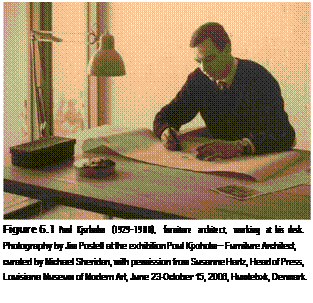 to designer, as it marked a line back to a disciplinary tradition and also reflected a distinct feature of his work: that every one of his designs engages in an intense dialogue with the space around it. Another important consideration of Poul Kjsrholm’s furniture designs is the expression and dependency on the material used and the fabrication employed. In a sense, his ideas about furniture design were formed in the workshop. He sketched (Figure 6.2), but he also made working prototypes as important steps in the design process for his furniture pieces (Figure 6.3). He made two prototypes of his aluminum chair (1953), which were necessary efforts to study the folding and riveting of the two aluminum halfshell components, the center notch beneath, the three legs, the simple upholstery, and the choice of fabric.
to designer, as it marked a line back to a disciplinary tradition and also reflected a distinct feature of his work: that every one of his designs engages in an intense dialogue with the space around it. Another important consideration of Poul Kjsrholm’s furniture designs is the expression and dependency on the material used and the fabrication employed. In a sense, his ideas about furniture design were formed in the workshop. He sketched (Figure 6.2), but he also made working prototypes as important steps in the design process for his furniture pieces (Figure 6.3). He made two prototypes of his aluminum chair (1953), which were necessary efforts to study the folding and riveting of the two aluminum halfshell components, the center notch beneath, the three legs, the simple upholstery, and the choice of fabric.
This chapter focuses on the processes of designing furniture. It introduces principles of furniture design and covers the phases, processes, and skills involved.
|
|
||
|
|||
|
|||
The ultimate goal of design is to synthesize tangible and intangible aspects and to create a unified whole out of an array of parts. Achieving part-to-whole relationships between components and interrelated systems is an important goal of design. In this sense, designing is a means of attaining order, arranging physical and spatial components along with intangible aspects to form a unified whole. Order governs the composition of any entity, including the human body, furniture, a building, or a natural landscape.
Gestalt psychology, formulated in 1930 by Max Wertheimer (1880-1943), Kurt Koffka (1886.1941), and Wolfgang Kohler (1887-1967), stated that human experience should be considered in a broad, comprehensive way, suggesting that the whole is greater than the sum of its parts.2 Building on this perspective, furniture design can be understood as an effort to infuse any number of intended purposes with physical parts, interrelated systems, structural forces, and utilitarian needs in greater wholes, with attention placed upon the simultaneity of systems (Figures 6.4 and 6.5). The Equa chair responds to support body movement without the use of mechanical adjustments. This was accomplished through the fine-tuning of a semirigid, injection-molded, slit shell made of glass-fiber-reinforced polyester. The split shell allows the seat and back to operate independently from the thicker side components.
Designing furniture is parallel to but different from designing a building or creating art. Furniture takes less time to create than a building and is one of many elements in interior space. Unlike art, furniture has pragmatic responsibility to function and very often serves several intended purposes.
Furniture design is disciplined work in which the designer combines technical information with prior experience, observation, and intuitive judgment, but systematic design considerations will not guarantee good results. There are many paths one can take in designing furniture. In nearly every case, the design process influences the final product. If you change the way you design, then you will change the way you think about design and, consequently, what you design. Paradigms about the design process (methods, required skills, anticipated outcomes, etc.) vary significantly based on professional, academic, and programmatic boundaries.
Disciplinary boundaries are acknowledged in this chapter because many designers approach furniture design from unique perspectives that often rely on discipline-specific means. Nonetheless, design principles are a common thread in all disciplines, so we begin with a brief review of design principles.


